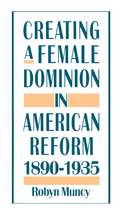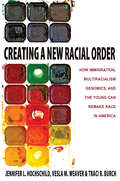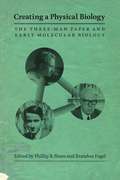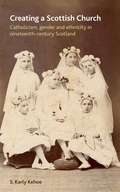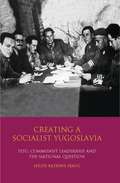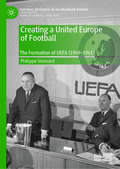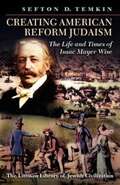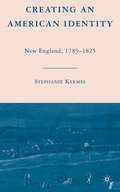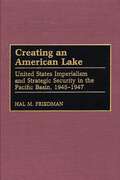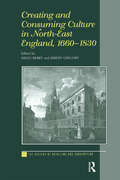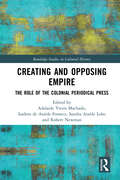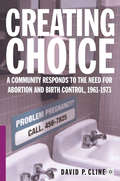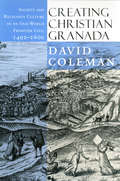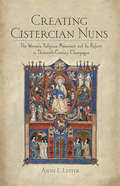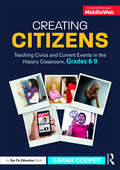- Table View
- List View
Creating a Female Dominion in American Reform, 1890-1935
by Robyn MuncyIn this book, Muncy explains the continuity of white, middle-class, American female reform activity between the Progressive era and the New Deal. She argues that during the Progressive era, female reformers built an interlocking set of organizations that attempted to control child welfare policy. Within this policymaking body, female progressives professionalized their values, bureaucratized their methods, and institutionalized their reforming networks. To refer to the organizational structure embodying these processes, the book develops the original concept of a female dominion in the otherwise male empire of policymaking. At the head of this dominion stood the Children's Bureau in the federal Department of Labor. Muncy investigates the development of the dominion and its particular characteristics, such as its monopoly over child welfare and its commitment to public welfare, and shows how it was dependent on a peculiarly female professionalism. By exploring that process, this book illuminates the relationship between professionalization and reform, the origins and meaning of Progressive reform, and the role of gender in creating the American welfare state.
Creating a Female Dominion in American Reform, 1890-1935
by Robyn MuncyIn this book, Muncy explains the continuity of white, middle-class, American female reform activity between the Progressive era and the New Deal. She argues that during the Progressive era, female reformers built an interlocking set of organizations that attempted to control child welfare policy. Within this policymaking body, female progressives professionalized their values, bureaucratized their methods, and institutionalized their reforming networks. To refer to the organizational structure embodying these processes, the book develops the original concept of a female dominion in the otherwise male empire of policymaking. At the head of this dominion stood the Children's Bureau in the federal Department of Labor. Muncy investigates the development of the dominion and its particular characteristics, such as its monopoly over child welfare and its commitment to public welfare, and shows how it was dependent on a peculiarly female professionalism. By exploring that process, this book illuminates the relationship between professionalization and reform, the origins and meaning of Progressive reform, and the role of gender in creating the American welfare state.
Creating a New Racial Order: How Immigration, Multiracialism, Genomics, and the Young Can Remake Race in America (PDF)
by Jennifer L. Hochschild Vesla M. Weaver Traci R. BurchThe American racial order--the beliefs, institutions, and practices that organize relationships among the nation's races and ethnicities--is undergoing its greatest transformation since the 1960s. Creating a New Racial Order takes a groundbreaking look at the reasons behind this dramatic change, and considers how different groups of Americans are being affected. Through revealing narrative and striking research, the authors show that the personal and political choices of Americans will be critical to how, and how much, racial hierarchy is redefined in decades to come. The authors outline the components that make up a racial order and examine the specific mechanisms influencing group dynamics in the United States: immigration, multiracialism, genomic science, and generational change. Cumulatively, these mechanisms increase heterogeneity within each racial or ethnic group, and decrease the distance separating groups from each other. The authors show that individuals are moving across group boundaries, that genomic science is challenging the whole concept of race, and that economic variation within groups is increasing. Above all, young adults understand and practice race differently from their elders: their formative memories are 9/11, Hurricane Katrina, and Obama's election--not civil rights marches, riots, or the early stages of immigration. Blockages could stymie or distort these changes, however, so the authors point to essential policy and political choices. Portraying a vision, not of a postracial America, but of a different racial America, Creating a New Racial Order examines how the structures of race and ethnicity are altering a nation.
Creating a Physical Biology: The Three-Man Paper and Early Molecular Biology
by Phillip R. Sloan and Brandon FogelIn 1935 geneticist Nikolai Timoféeff-Ressovsky, radiation physicist Karl G. Zimmer, and quantum physicist Max Delbrück published “On the Nature of Gene Mutation and Gene Structure,” known subsequently as the “Three-Man Paper.” This seminal paper advanced work on the physical exploration of the structure of the gene through radiation physics and suggested ways in which physics could reveal definite information about gene structure, mutation, and action. Representing a new level of collaboration between physics and biology, it played an important role in the birth of the new field of molecular biology. The paper’s results were popularized for a wide audience in the What is Life? lectures of physicist Erwin Schrödinger in 1944. Despite its historical impact on the biological sciences, the paper has remained largely inaccessible because it was only published in a short-lived German periodical. Creating a Physical Biology makes the Three Man Paper available in English for the first time. Brandon Fogel’s translation is accompanied by an introductory essay by Fogel and Phillip Sloan and a set of essays by leading historians and philosophers of biology that explore the context, contents, and subsequent influence of the paper, as well as its importance for the wider philosophical analysis of biological reductionism.
Creating a Physical Biology: The Three-Man Paper and Early Molecular Biology
by Phillip R. Sloan and Brandon FogelIn 1935 geneticist Nikolai Timoféeff-Ressovsky, radiation physicist Karl G. Zimmer, and quantum physicist Max Delbrück published “On the Nature of Gene Mutation and Gene Structure,” known subsequently as the “Three-Man Paper.” This seminal paper advanced work on the physical exploration of the structure of the gene through radiation physics and suggested ways in which physics could reveal definite information about gene structure, mutation, and action. Representing a new level of collaboration between physics and biology, it played an important role in the birth of the new field of molecular biology. The paper’s results were popularized for a wide audience in the What is Life? lectures of physicist Erwin Schrödinger in 1944. Despite its historical impact on the biological sciences, the paper has remained largely inaccessible because it was only published in a short-lived German periodical. Creating a Physical Biology makes the Three Man Paper available in English for the first time. Brandon Fogel’s translation is accompanied by an introductory essay by Fogel and Phillip Sloan and a set of essays by leading historians and philosophers of biology that explore the context, contents, and subsequent influence of the paper, as well as its importance for the wider philosophical analysis of biological reductionism.
Creating a Physical Biology: The Three-Man Paper and Early Molecular Biology
by Phillip R. Sloan and Brandon FogelIn 1935 geneticist Nikolai Timoféeff-Ressovsky, radiation physicist Karl G. Zimmer, and quantum physicist Max Delbrück published “On the Nature of Gene Mutation and Gene Structure,” known subsequently as the “Three-Man Paper.” This seminal paper advanced work on the physical exploration of the structure of the gene through radiation physics and suggested ways in which physics could reveal definite information about gene structure, mutation, and action. Representing a new level of collaboration between physics and biology, it played an important role in the birth of the new field of molecular biology. The paper’s results were popularized for a wide audience in the What is Life? lectures of physicist Erwin Schrödinger in 1944. Despite its historical impact on the biological sciences, the paper has remained largely inaccessible because it was only published in a short-lived German periodical. Creating a Physical Biology makes the Three Man Paper available in English for the first time. Brandon Fogel’s translation is accompanied by an introductory essay by Fogel and Phillip Sloan and a set of essays by leading historians and philosophers of biology that explore the context, contents, and subsequent influence of the paper, as well as its importance for the wider philosophical analysis of biological reductionism.
Creating a Physical Biology: The Three-Man Paper and Early Molecular Biology
by Phillip R. SloanIn 1935 geneticist Nikolai Timoféeff-Ressovsky, radiation physicist Karl G. Zimmer, and quantum physicist Max Delbrück published “On the Nature of Gene Mutation and Gene Structure,” known subsequently as the “Three-Man Paper.” This seminal paper advanced work on the physical exploration of the structure of the gene through radiation physics and suggested ways in which physics could reveal definite information about gene structure, mutation, and action. Representing a new level of collaboration between physics and biology, it played an important role in the birth of the new field of molecular biology. The paper’s results were popularized for a wide audience in the What is Life? lectures of physicist Erwin Schrödinger in 1944. Despite its historical impact on the biological sciences, the paper has remained largely inaccessible because it was only published in a short-lived German periodical. Creating a Physical Biology makes the Three Man Paper available in English for the first time. Brandon Fogel’s translation is accompanied by an introductory essay by Fogel and Phillip Sloan and a set of essays by leading historians and philosophers of biology that explore the context, contents, and subsequent influence of the paper, as well as its importance for the wider philosophical analysis of biological reductionism.
Creating a Physical Biology: The Three-Man Paper and Early Molecular Biology
by Phillip R. Sloan Fogel Brandon Brandon FogelIn 1935 geneticist Nikolai Timoféeff-Ressovsky, radiation physicist Karl G. Zimmer, and quantum physicist Max Delbrück published “On the Nature of Gene Mutation and Gene Structure,” known subsequently as the “Three-Man Paper.” This seminal paper advanced work on the physical exploration of the structure of the gene through radiation physics and suggested ways in which physics could reveal definite information about gene structure, mutation, and action. Representing a new level of collaboration between physics and biology, it played an important role in the birth of the new field of molecular biology. The paper’s results were popularized for a wide audience in the What is Life? lectures of physicist Erwin Schrödinger in 1944. Despite its historical impact on the biological sciences, the paper has remained largely inaccessible because it was only published in a short-lived German periodical. Creating a Physical Biology makes the Three Man Paper available in English for the first time. Brandon Fogel’s translation is accompanied by an introductory essay by Fogel and Phillip Sloan and a set of essays by leading historians and philosophers of biology that explore the context, contents, and subsequent influence of the paper, as well as its importance for the wider philosophical analysis of biological reductionism.
Creating a Physical Biology: The Three-Man Paper and Early Molecular Biology
by Phillip R. Sloan Brandon FogelIn 1935 geneticist Nikolai Timoféeff-Ressovsky, radiation physicist Karl G. Zimmer, and quantum physicist Max Delbrück published “On the Nature of Gene Mutation and Gene Structure,” known subsequently as the “Three-Man Paper.” This seminal paper advanced work on the physical exploration of the structure of the gene through radiation physics and suggested ways in which physics could reveal definite information about gene structure, mutation, and action. Representing a new level of collaboration between physics and biology, it played an important role in the birth of the new field of molecular biology. The paper’s results were popularized for a wide audience in the What is Life? lectures of physicist Erwin Schrödinger in 1944. Despite its historical impact on the biological sciences, the paper has remained largely inaccessible because it was only published in a short-lived German periodical. Creating a Physical Biology makes the Three Man Paper available in English for the first time. Brandon Fogel’s translation is accompanied by an introductory essay by Fogel and Phillip Sloan and a set of essays by leading historians and philosophers of biology that explore the context, contents, and subsequent influence of the paper, as well as its importance for the wider philosophical analysis of biological reductionism.
Creating a Scottish church: Catholicism, gender and ethnicity in nineteenth-century Scotland
by S. Karly KehoeA book about how Scotland’s Catholics participated in the extension of citizenship in Scotland and how it was transformed from an underground and isolated church to a multi-faceted institution that existed on a national scale.
Creating a Socialist Yugoslavia: Tito, Communist Leadership and the National Question (International Library of Twentieth Century History)
by Hilde Katrine HaugThe Yugoslav communist leaders aspired to create a socialist Yugoslavia, and when they came into power in 1945, they claimed to have introduced a socialist solution to the Yugoslav national question. But what did it imply to 'solve a national question' and what did introducing a 'socialist solution' to a national question entail? 'Creating a Socialist Yugoslavia: Tito, Communist Leadership and the National Question' charts how the Yugoslav Communist leaders approached the national question, and what influence the complex national relations in the multinational state of Yugoslavia had on the development of the Yugoslav communists' policies, and on their post-war socialist project. From 1935 to 1990, tremendous changes took place in the Yugoslav approach to the national question, and in the institutions they devised as part of this solution. There were also significant changes to the role of the republics and the relations between the different national groups within the Yugoslav state. Discussions on the national question were not absent during this period, despite the communists claim to have solved it. Debates over what kind of Yugoslav unity was the most desirable continued to be a question of contention and different groups had different visions of this. A struggle over resources also developed between different republics. This book identifies and examines four particular phases in the communists' strategies towards the national question; each marked by particular processes, issues and challenges. The claim to have solved the national question often meant that this issue could not be discussed openly and had to be expressed in a particular rhetoric approved by the Party. 'Creating a Socialist Yugoslavia' provides an authoritative account of the Yugoslav communist leaders' national policy and attempts to deal with the challenges encountered by the communists in reconciling their aspiration to create a socialist Yugoslavia with the need to regulate national conflict within the federation.
Creating a United Europe of Football: The Formation of UEFA (1949–1961) (Football Research in an Enlarged Europe)
by Philippe VonnardThis book provides a historical study of the beginnings of the UEFA, demonstrating how the formation of the organisation was linked to the decentralisation experienced by FIFA, the world governing body of football. Vonnard examines why administrators created an association that transcended the barriers of the Cold War, and focused on the development of a network that promoted football outside the constraints of international politics. Finally, he emphasises the role UEFA played in the Europeanisation of the people’s game, and in the early years of the European integration process. The research is based on a rich body of new archival material from the UEFA and FIFA Documentation Centres, and various European football federations, as well as reports from a number of leading newspapers of the era, and interviews with football personalities of the 1950s. It will be of interest to students and scholars across the history of sport, international relations, and European studies
Creating American Reform Judaism: The Life and Times of Isaac Mayer Wise (The Littman Library of Jewish Civilization)
by Sefton D. TemkinIsaac Mayer Wise (1819–1900), founder of the major institutions of Reform Judaism in America, was a man of his time—a pioneer in a pioneer’s world. When he came to America from his childhood Bohemia in 1846, he found fewer than 50,000 Jews and only two ordained rabbis. With his sense of mission and tireless energy, he set himself to tailoring the vehicle of Reform Judaism to meet the needs of the growing Jewish community. Wise strove for unity among American Jews, and for a college to train rabbis to serve them. The establishment of Hebrew Union College (1875) was the crowning achievement of his life. His quest for unity also led him to draw up an American Jewish prayer-book, Minhag America, to found the Central Conference of American Rabbis, and to edit two weeklies; their editorials, breathing fire and energy, were no less important in his quest for leadership. Here as elsewhere, it was his persistence that won him the war where his impetuosity lost him many battles. Professor Temkin’s writing captures the vigour of Wise’s personality and the politics and concerns of contemporary Jewish life and leadership in America. Based primarily on material in the American Jewish Archives of the Hebrew Union College, this biography is a lively portrait of a rabbi whose singular efforts in many fields made him a pivotal figure in the naturalization of the Jew and Judaism in the New World. The book was first published in hardback in 1992 under the title Isaac Mayer Wise: Shaping American Judaism.
Creating an American Identity: New England, 1789–1825
by S. KermesCreating an American Identity examines the relationship between regionalism and nationalism in New England. Focusing on the years 1789-1825, it analyzes the process by which New Englanders used trans-Atlantic symbols as well as regional landscapes, values, and characteristics to create an American identity.
Creating an American Lake: United States Imperialism and Strategic Security in the Pacific Basin, 1945-1947 (Contributions in Military Studies)
by Hal M. FriedmanMany historians of U.S. foreign relations think of the post-World War II period as a time when the United States, as an anti-colonial power, advocated collective security through the United Nations and denounced territorial aggrandizement. Yet between 1945 and 1947, the United States violated its wartime rhetoric and instead sought an imperial solution to its postwar security problems in East Asia by acquiring unilateral control of the western Pacific Islands and dominating influence throughout the entire Pacific Basin. This detailed study examines American foreign policy from the beginning of the Truman Administration to the implementation of Containment in the summer and fall of 1947. As a case study of the Truman Administration's Early Cold War efforts, it explores pre-Containment policy in light of U.S. security concerns vis-a-vis the Pearl Harbor Syndrome.The American pursuit of a secure Pacific Basin was inconsistent at the time with its foreign policy toward other areas of the world. Thus, the consolidation of power in this region was an exception to the avowed goal of a multilateral response to the policies of the Soviet Union. This example of national or strategic security went much further than simple military control; it included the cultural assimilation of the indigenous population and the unilateral exclusion of all other powers. Analyzing traditional archival records in a new light, Friedman also investigates the persisting American notions of a Westward moving frontier that stretches beyond North American territorial bounds.
Creating and Consuming Culture in North-East England, 1660–1830 (The History of Retailing and Consumption)
by Helen Berry Jeremy GregoryHistorians of the long eighteenth century have recently recognised that this period is central both to the history of cultural production and consumption and to the history of national and regional identity. Yet no book has, as yet, directly engaged with these two areas of interest at the same time. By uniting interest in the history of culture with the history of regional identity, Creating and Consuming Culture in North-East England, 1660-1830 is of crucial importance to a wide range of historians and intervenes in a number of highly important historical and conceptual debates in a timely and provocative way. The book makes a substantial contribution to eighteenth-century studies. Not only do these essays demonstrate that in thinking about cultural production and consumption in the eighteenth century there are important continuities as well as changes that need to be considered, but also they complicate the commonplace assumption of metropolitan-led cultural change and cultural innovation. Rather than the usual model of centre-periphery diffusion, a number of contributions show that cultural change in the provinces was happening at the same time as in, or in some cases even before, London. The essays also indicate the complex relationship between cultural consumption and social status, with some cultural forms being more inclusive than others.
Creating and Consuming Culture in North-East England, 1660–1830 (The History of Retailing and Consumption)
by Helen Berry Jeremy GregoryHistorians of the long eighteenth century have recently recognised that this period is central both to the history of cultural production and consumption and to the history of national and regional identity. Yet no book has, as yet, directly engaged with these two areas of interest at the same time. By uniting interest in the history of culture with the history of regional identity, Creating and Consuming Culture in North-East England, 1660-1830 is of crucial importance to a wide range of historians and intervenes in a number of highly important historical and conceptual debates in a timely and provocative way. The book makes a substantial contribution to eighteenth-century studies. Not only do these essays demonstrate that in thinking about cultural production and consumption in the eighteenth century there are important continuities as well as changes that need to be considered, but also they complicate the commonplace assumption of metropolitan-led cultural change and cultural innovation. Rather than the usual model of centre-periphery diffusion, a number of contributions show that cultural change in the provinces was happening at the same time as in, or in some cases even before, London. The essays also indicate the complex relationship between cultural consumption and social status, with some cultural forms being more inclusive than others.
Creating and Failing the 9/11 Generation: The Real Story of September 11
by Matthew WarshauerThrough a chronological and thematical approach, this book examines the terrorist attacks on September 11, 2001 and the effect on what President George W. Bush recognized as the 9/11 Generation.By providing cultural and generational context to 9/11 and its impact on the U.S., this book is the first study to ensure that the voices of this young generation are put at the forefront of analysis. Creating and Failing the 9/11 Generation answers “what happened” and “why” but, more importantly, it reveals the importance of broader themes and ideas such as foreign policy, security, patriotism, the U.S. military, and American democracy. The final chapter, "9/11 and the World," places the events in America on a global scale and demonstrates how 9/11 has remained, and will remain, significant to understanding how different places and cultures interact with each other in the modern world.Creating and Failing the 9/11 Generation is useful for all students who study U.S. foreign relations, terrorism, warfare, memory studies, and the history of modern America.
Creating and Failing the 9/11 Generation: The Real Story of September 11
by Matthew WarshauerThrough a chronological and thematical approach, this book examines the terrorist attacks on September 11, 2001 and the effect on what President George W. Bush recognized as the 9/11 Generation.By providing cultural and generational context to 9/11 and its impact on the U.S., this book is the first study to ensure that the voices of this young generation are put at the forefront of analysis. Creating and Failing the 9/11 Generation answers “what happened” and “why” but, more importantly, it reveals the importance of broader themes and ideas such as foreign policy, security, patriotism, the U.S. military, and American democracy. The final chapter, "9/11 and the World," places the events in America on a global scale and demonstrates how 9/11 has remained, and will remain, significant to understanding how different places and cultures interact with each other in the modern world.Creating and Failing the 9/11 Generation is useful for all students who study U.S. foreign relations, terrorism, warfare, memory studies, and the history of modern America.
Creating and Opposing Empire: The Role of the Colonial Periodical Press (Routledge Studies in Cultural History)
by Adelaide Vieira Machado Isadora De Ataíde Fonseca Sandra Ataíde Lobo Robert NewmanFocusing on the Portuguese Empire, this book examines colonial press issued in "metropolitan" spaces and in colonies, disclosing dissonant narratives and problematizations of colonial empires.Creating and Opposing Empire is a venture of the International Group for Studies of Colonial Periodical Press of the Portuguese Empire (IGSCP-PE), which also invests on comparative studies and conceptual discussions. This book analyses representations of Empire at colonial press published in "metropolitan" spaces and in colonies. By joining these spaces in the same analytic look, it explores different problematizations of colonial empires. The diversity of angles discloses why a decolonized, democratic, understanding of the world modulated by modern colonial empires needs to navigate the seas of dissonant narratives of community, nation, and empire. The book deals with the ideas that in their complexity and dynamism, until late in the twentieth century, were moulded in the game between the cultural context of representations and the universality of concepts. The studies range from approaches to International Exhibitions, Metropolitan Press, Colonial Models, Missionary Press, Literary Discourses, Colonial and Postcolonial Press, Constructing the "Others", Anticolonial Press, Democracy, Dictatorship, Censorship, Colonial Prison’s Press, among other themes. Its primordial focus on the Portuguese Empire, introduces perspectives rarely included in international discussions on colonial and imperial press histories.This book is essential for scholars and students in Media Studies, Modern History, Cultural, Literary Studies and Political Science.
Creating and Opposing Empire: The Role of the Colonial Periodical Press (Routledge Studies in Cultural History)
by Adelaide Vieira Machado Isadora de Ataíde Fonseca Robert S. Newman Sandra Ataíde LoboFocusing on the Portuguese Empire, this book examines colonial press issued in "metropolitan" spaces and in colonies, disclosing dissonant narratives and problematizations of colonial empires.Creating and Opposing Empire is a venture of the International Group for Studies of Colonial Periodical Press of the Portuguese Empire (IGSCP-PE), which also invests on comparative studies and conceptual discussions. This book analyses representations of Empire at colonial press published in "metropolitan" spaces and in colonies. By joining these spaces in the same analytic look, it explores different problematizations of colonial empires. The diversity of angles discloses why a decolonized, democratic, understanding of the world modulated by modern colonial empires needs to navigate the seas of dissonant narratives of community, nation, and empire. The book deals with the ideas that in their complexity and dynamism, until late in the twentieth century, were moulded in the game between the cultural context of representations and the universality of concepts. The studies range from approaches to International Exhibitions, Metropolitan Press, Colonial Models, Missionary Press, Literary Discourses, Colonial and Postcolonial Press, Constructing the "Others", Anticolonial Press, Democracy, Dictatorship, Censorship, Colonial Prison’s Press, among other themes. Its primordial focus on the Portuguese Empire, introduces perspectives rarely included in international discussions on colonial and imperial press histories.This book is essential for scholars and students in Media Studies, Modern History, Cultural, Literary Studies and Political Science.
Creating Choice: A Community Responds to the Need for Abortion and Birth Control, 1961-1973 (Palgrave Studies in Oral History)
by D. ClineBefore Roe v. Wade, somewhere between one and two million illegal abortions were performed every year in the United States. Illegal abortion affected millions of women and their families, yet their stories remain hidden. In Creating Choice , citizens of one community in Western Massachusetts' Pioneer Valley break that silence.
Creating Christian Granada: Society and Religious Culture in an Old-World Frontier City, 1492–1600
by David ColemanCreating Christian Granada provides a richly detailed examination of a critical and transitional episode in Spain's march to global empire. The city of Granada—Islam's final bastion on the Iberian peninsula—surrendered to the control of Spain's "Catholic Monarchs" Isabella and Ferdinand on January 2, 1492. Over the following century, Spanish state and Church officials, along with tens of thousands of Christian immigrant settlers, transformed the formerly Muslim city into a Christian one. With constant attention to situating the Granada case in the broader comparative contexts of the medieval reconquista tradition on the one hand and sixteenth-century Spanish imperialism in the Americas on the other, Coleman carefully charts the changes in the conquered city's social, political, religious, and physical landscapes. In the process, he sheds light on the local factors contributing to the emergence of tensions between the conquerors and Granada's formerly Muslim, "native" morisco community in the decades leading up to the crown-mandated expulsion of most of the city's moriscos in 1569–1570.Despite the failure to assimilate the moriscos, Granada's status as a frontier Christian community under construction fostered among much of the immigrant community innovative religious reform ideas and programs that shaped in direct ways a variety of church-wide reform movements in the era of the ecumenical Council of Trent (1545–1563). Coleman concludes that the process by which reforms of largely Granadan origin contributed significantly to transformations in the Church as a whole forces a reconsideration of traditional "top-down" conceptions of sixteenth-century Catholic reform.
Creating Cistercian Nuns: The Women's Religious Movement and Its Reform in Thirteenth-Century Champagne
by Anne E. LesterIn Creating Cistercian Nuns, Anne E. Lester addresses a central issue in the history of the medieval church: the role of women in the rise of the religious reform movement of the thirteenth century. Focusing on the county of Champagne in France, Lester reconstructs the history of the women’s religious movement and its institutionalization within the Cistercian order.The common picture of the early Cistercian order is that it was unreceptive to religious women. Male Cistercian leaders often avoided institutional oversight of communities of nuns, preferring instead to cultivate informal relationships of spiritual advice and guidance with religious women. As a result, scholars believed that women who wished to live a life of service and poverty were more likely to join one of the other reforming orders rather than the Cistercians. As Lester shows, however, this picture is deeply flawed. Between 1220 and 1240 the Cistercian order incorporated small independent communities of religious women in unprecedented numbers. Moreover, the order not only accommodated women but also responded to their interpretations of apostolic piety, even as it defined and determined what constituted Cistercian nuns in terms of dress, privileges, and liturgical practice. Lester reconstructs the lived experiences of these women, integrating their ideals and practices into the broader religious and social developments of the thirteenth century—including the crusade movement, penitential piety, the care of lepers, and the reform agenda of the Fourth Lateran Council. The book closes by addressing the reasons for the subsequent decline of Cistercian convents in the fourteenth century. Based on extensive analysis of unpublished archives, Creating Cistercian Nuns will force scholars to revise their understanding of the women’s religious movement as it unfolded during the thirteenth century.
Creating Citizens: Teaching Civics and Current Events in the History Classroom, Grades 6–9
by Sarah CooperEngage students in meaningful civic learning and encourage them to become active and informed citizens. With this essential book, co-published by Routledge and MiddleWeb, you will gain a variety of practical strategies for teaching civics and current events to your middle school students. Author and expert teacher Sarah Cooper takes you into her school and shares her classroom-tested methods and tools. Topics include: Fitting current events into an already-packed history curriculum Staying nonpartisan and fostering balanced discussions Helping students find their stake in the news Teaching civic literacy through primary sources, then and now Encouraging students to invest in analytical writing Fostering student ownership of our classrooms through discussion and debate Cultivating citizenship through empathy and community engagement Throughout the book, you’ll find student examples, handouts, and rubrics, so that you can easily implement the ideas in your own classroom. By getting your students to think critically about current events, you will help them become passionate writers, thinkers, and involved citizens.
